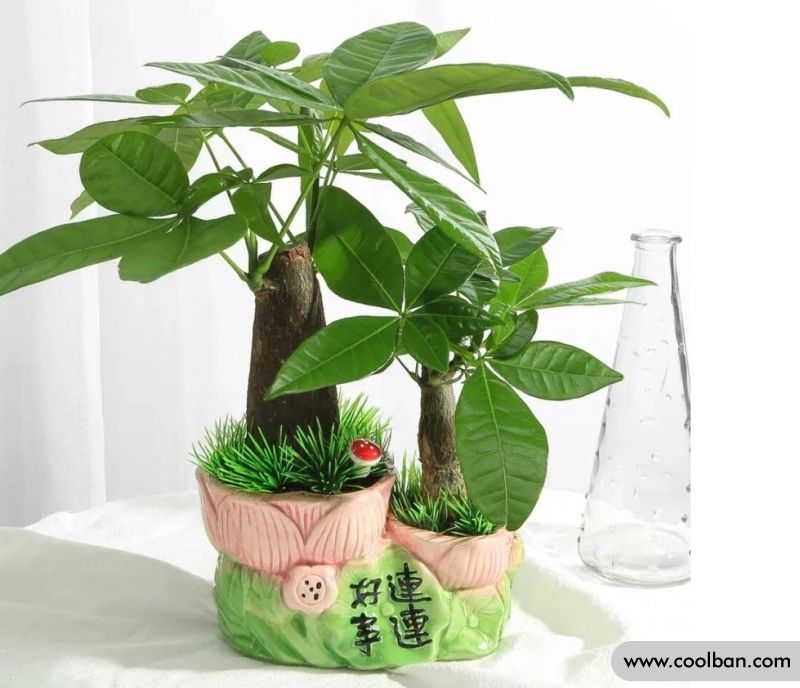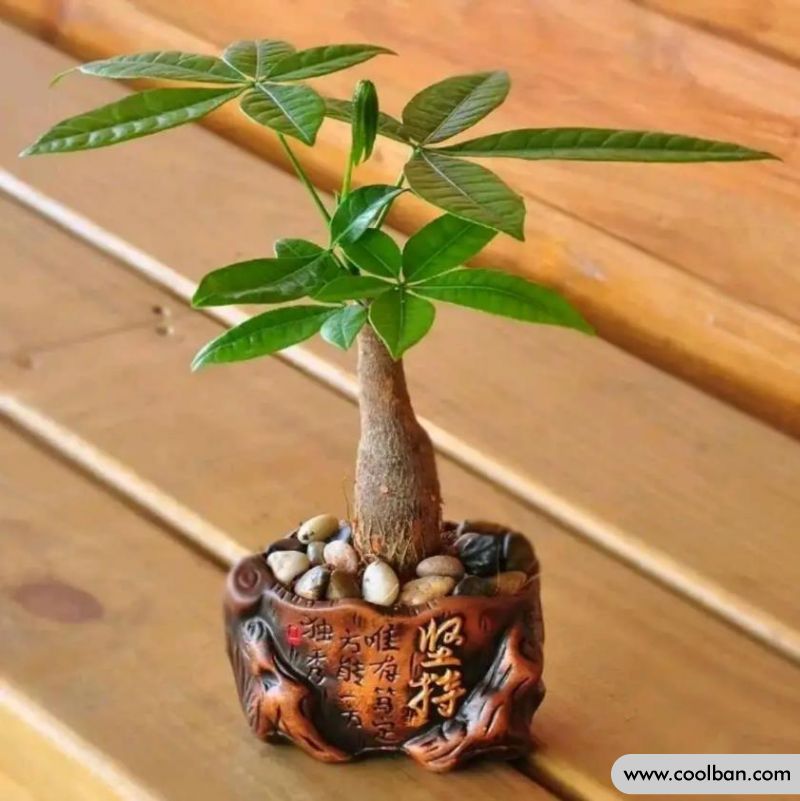How to deal with the yellowing of the leaves of the fortune tree
2022-05-09
The fortune tree is a popular indoor green, but the yellow leaves of the fortune tree are also a nuisance. Why do the leaves of the fortune tree turn yellow? Let's take a look at the reasons and what to do about it.

The reason why the leaves of the fortune tree turn yellow
Reason 1: Too much watering
Some plants do not need frequent watering, such as the money tree. Frequent watering will make the soil too wet, cause the soil to lack oxygen, make some fibrous roots rot, hinder normal respiration and absorption of water and nutrients, and cause the leaves to turn yellow and fall off.
Reason 2: Drought and dehydration
If the plant is not watered for a long time, it will inevitably cause the leaves to turn yellow. Improper watering will cause the soil to become dry and wet, which will also affect the absorption of nutrients and easily cause leaves to wither and droop. First, the lower old leaves age, and gradually yellow and fall off from the bottom to the top. Water or spray sparingly, then water as normal when the plants are back to normal.
Reason 3: Too much fertilization
Excessive fertilization will lead to excess nutrients in the plant, uneven hypertrophy of new leaves, and yellowing of the dry tips of old leaves. At this point, stop fertilizing and increase watering to allow fertilizer to flow out of the basin.
Reason 4: Hot, high temperature or excessive shade
Placing a fortune tree in direct sunlight for a long time can also easily lead to coking of young leaves at the tips and edges, or yellowing and falling off. At this point, it should be moved to a cool, ventilated place.
Leaving the lucky tree in the shade or in a place with insufficient light for a long time will also cause the leaves of the lucky tree to turn yellow. The fortune tree is highly tolerant to shade and can be placed indoors for 2 to 4 weeks before placing it in a sunny place, but it should not be placed in a place without sunlight for a long time.
Reason 5: Damage caused by pests and diseases
Leaf spot is caused when plants are attacked by fungi and other pathogens. Local necrosis of leaves or macular or plaque occurs at this time. In severe cases, it will cause yellowing and falling off. At this time, the plants should be sprayed with drug control.
Reason 6: The temperature is too low
The yellowing of the leaves of the fortune tree is also related to temperature. The minimum temperature in winter planting environment is 16-18 ℃. Below this temperature, the leaves turn yellow and fall off; below 10°C, it is easy to die. The fortune tree can be watered less in winter, and occasionally spray water on the leaves.

What should I do if the leaves of the Fortune Tree turn yellow
The fortune tree is a difficult plant to grow, and the leaves tend to turn yellow. What if the leaves turn yellow?
Method 1: Pay attention to the amount of watering. If the fortune tree pot is watered too much, the leaves will turn yellow. So be careful when raising it. It is generally found that dry soil appears on the soil surface of the fortune tree, and it is only watered, and it is not necessary to water every day.
Method 2: Fortune Tree likes shade. Fortune tree is a drought tolerant plant. We all think that plants need photosynthesis, so we put the fortune tree in the sun to bask in the sun. The fortune tree does not like to be exposed to the sun, and the sun will only make the leaves of the fortune tree turn yellow. Although it can't be exposed to the sun, it's not impossible to sunbathe. We can place it not far from the sun, just as the sun is scattered on the leaves.
Method 3: Removal of aphids. If you find that the leaves are turning yellow, see if there are insects biting or crawling over, you can ask a professional gardener to give you a little insecticide to kill the insects.
Method 4: Add some fertilizer. The yellowing of the leaves of the fortune tree may be a reminder that some fertilizers or nutrients need to be added to the nitrogen. It is recommended to apply nitrogen-containing fertilizers once in a while.
Method 5: Pruning. A fortune tree that grows too well can also cause the leaves to turn yellow. Because of the lush foliage and too much competition, the leaves turn yellow. It's time to trim it.

Cultivation method of fortune tree
The cultivation of the fortune tree is very particular, and professional methods are required from the environment to the soil.
Method 1: A sunny and shade-tolerant environment. Fortune trees are generally planted in shady places, but if things go on like this, the growth will get worse and worse. Occasionally needs some sunlight. In summer, 50 percent shade is best, as the sun can turn spiky and yellowing leaves. Indoor growing sites must have a certain amount of scattered light, and such an environment is not suitable for more than 30 days.
Method 2: The soil should be loose. Wealth trees bought from farms have soil, we don't have to replace them right away. Wait until you have planted for a while before thinking about it. If you want to change the soil, you can choose loose vegetable garden soil, peat soil, leaf mulch, coarse sand, and add some compound fertilizer or chicken manure as base fertilizer.
Method 3: Do not overwater. Because the roots of the fortune tree are underdeveloped, frequent watering will cause the roots to rot. Watering usually depends on how moist the soil is. In fact, the plant will not wilt immediately if it lacks water, and it will grow back with a little water. But if there is too much water, the plants cannot be saved.
Method 4: Fertilize thinly. At the beginning of cultivating a lucky tree, no fertilization is required. After a long time, you can consider some foliage fertilizers, thin fertilizers, and never heavy fertilizers.
Method 5: Pay attention to pests. If the stem of the fortune tree is found to be black, or black fibers appear, it is usually stem rot. In the early stage of the disease, it can be sprayed with 1000 times of 50% sterilization king water-soluble powder, once every 10 days, 2-3 times in a row

The reason why the leaves of the fortune tree turn yellow
Reason 1: Too much watering
Some plants do not need frequent watering, such as the money tree. Frequent watering will make the soil too wet, cause the soil to lack oxygen, make some fibrous roots rot, hinder normal respiration and absorption of water and nutrients, and cause the leaves to turn yellow and fall off.
Reason 2: Drought and dehydration
If the plant is not watered for a long time, it will inevitably cause the leaves to turn yellow. Improper watering will cause the soil to become dry and wet, which will also affect the absorption of nutrients and easily cause leaves to wither and droop. First, the lower old leaves age, and gradually yellow and fall off from the bottom to the top. Water or spray sparingly, then water as normal when the plants are back to normal.
Reason 3: Too much fertilization
Excessive fertilization will lead to excess nutrients in the plant, uneven hypertrophy of new leaves, and yellowing of the dry tips of old leaves. At this point, stop fertilizing and increase watering to allow fertilizer to flow out of the basin.
Reason 4: Hot, high temperature or excessive shade
Placing a fortune tree in direct sunlight for a long time can also easily lead to coking of young leaves at the tips and edges, or yellowing and falling off. At this point, it should be moved to a cool, ventilated place.
Leaving the lucky tree in the shade or in a place with insufficient light for a long time will also cause the leaves of the lucky tree to turn yellow. The fortune tree is highly tolerant to shade and can be placed indoors for 2 to 4 weeks before placing it in a sunny place, but it should not be placed in a place without sunlight for a long time.
Reason 5: Damage caused by pests and diseases
Leaf spot is caused when plants are attacked by fungi and other pathogens. Local necrosis of leaves or macular or plaque occurs at this time. In severe cases, it will cause yellowing and falling off. At this time, the plants should be sprayed with drug control.
Reason 6: The temperature is too low
The yellowing of the leaves of the fortune tree is also related to temperature. The minimum temperature in winter planting environment is 16-18 ℃. Below this temperature, the leaves turn yellow and fall off; below 10°C, it is easy to die. The fortune tree can be watered less in winter, and occasionally spray water on the leaves.

What should I do if the leaves of the Fortune Tree turn yellow
The fortune tree is a difficult plant to grow, and the leaves tend to turn yellow. What if the leaves turn yellow?
Method 1: Pay attention to the amount of watering. If the fortune tree pot is watered too much, the leaves will turn yellow. So be careful when raising it. It is generally found that dry soil appears on the soil surface of the fortune tree, and it is only watered, and it is not necessary to water every day.
Method 2: Fortune Tree likes shade. Fortune tree is a drought tolerant plant. We all think that plants need photosynthesis, so we put the fortune tree in the sun to bask in the sun. The fortune tree does not like to be exposed to the sun, and the sun will only make the leaves of the fortune tree turn yellow. Although it can't be exposed to the sun, it's not impossible to sunbathe. We can place it not far from the sun, just as the sun is scattered on the leaves.
Method 3: Removal of aphids. If you find that the leaves are turning yellow, see if there are insects biting or crawling over, you can ask a professional gardener to give you a little insecticide to kill the insects.
Method 4: Add some fertilizer. The yellowing of the leaves of the fortune tree may be a reminder that some fertilizers or nutrients need to be added to the nitrogen. It is recommended to apply nitrogen-containing fertilizers once in a while.
Method 5: Pruning. A fortune tree that grows too well can also cause the leaves to turn yellow. Because of the lush foliage and too much competition, the leaves turn yellow. It's time to trim it.

Cultivation method of fortune tree
The cultivation of the fortune tree is very particular, and professional methods are required from the environment to the soil.
Method 1: A sunny and shade-tolerant environment. Fortune trees are generally planted in shady places, but if things go on like this, the growth will get worse and worse. Occasionally needs some sunlight. In summer, 50 percent shade is best, as the sun can turn spiky and yellowing leaves. Indoor growing sites must have a certain amount of scattered light, and such an environment is not suitable for more than 30 days.
Method 2: The soil should be loose. Wealth trees bought from farms have soil, we don't have to replace them right away. Wait until you have planted for a while before thinking about it. If you want to change the soil, you can choose loose vegetable garden soil, peat soil, leaf mulch, coarse sand, and add some compound fertilizer or chicken manure as base fertilizer.
Method 3: Do not overwater. Because the roots of the fortune tree are underdeveloped, frequent watering will cause the roots to rot. Watering usually depends on how moist the soil is. In fact, the plant will not wilt immediately if it lacks water, and it will grow back with a little water. But if there is too much water, the plants cannot be saved.
Method 4: Fertilize thinly. At the beginning of cultivating a lucky tree, no fertilization is required. After a long time, you can consider some foliage fertilizers, thin fertilizers, and never heavy fertilizers.
Method 5: Pay attention to pests. If the stem of the fortune tree is found to be black, or black fibers appear, it is usually stem rot. In the early stage of the disease, it can be sprayed with 1000 times of 50% sterilization king water-soluble powder, once every 10 days, 2-3 times in a row
